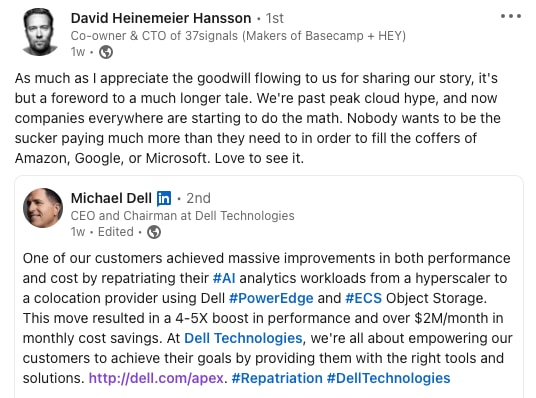A typically controversial post from the CTO of 37signals about moving HEY’s servers out of the cloud has re-ignited the debates around cloud repatriation. To say that ‘opinion is divided’ would be to understate the almost religious nature of the online debate, from the trenchant and sarcastic on one side…
I swear the idea that cloud workload "repatriation" is a good idea gets just more absurd the longer I think about it and it started out pretty high on the absurdity scale.
— Camille Fournier (@skamille) July 14, 2021
…to the hopeful and optimistic on the other. Sometimes we even see both sides represented in the same source:

Many are tempted to follow Corey Quinn when he argues that ‘cloud repatriation isn’t a thing’ and share his cynicism that ‘Far and away the folks who seem the most enthusiastic about cloud repatriation are vendors who stand to gain a heck of a lot if people start turning their backs on public cloud’ on the Duckbill blog. The Duckbill Group helps businesses cut their cloud costs, so it may be fair to conclude from this that most commentators on this have a lot of skin in the game either way1.
On the pro-repatriation side, an often-cited article by Andreessen Horowitz states bluntly as a summary that ‘You’re crazy if you don’t start in the cloud; you’re crazy if you stay on it.’
To summarise: repatriation is both a thing and not a thing depending on who you ask, and is an absurd thing to contemplate while being a crazy thing not to contemplate. How do we calmly make sense of all this?
Is anyone doing it?
It’s fair to say that we are not drowning in examples of high profile businesses that are moving significant chunks of cloud services out of the hyperscalers’ clutches. The poster child for repatriation is Dropbox, who announced in 2016 that they had spent $53 million building a colocated hardware and software infrastructure to store the exabytes of data that are at the core of their business.
Both Dropbox and the HEY example mentioned previously are SaaS businesses, and this is also what the Andreessen Horowitz article focuses on. SaaS businesses are typically businesses ‘born in the cloud’, and so their moving back to on-prem or colocation infrastructure is often considered big news. They are also younger and highly tech-focussed businesses, so also more likely to shout about their move from the rooftops.
Apart from Dropbox and HEY, there have not been many businesses that have made a splash of any cloud repatriation effort. Gartner has also poured cold water on any hype with a paper published in 2019 titled ‘Public Cloud Repatriation Remains the Exception, Not the Rule’.
There have also been notable repatriation reversals, such as Zynga, the mobile gaming company who built their own zCloud infrastructure back in 2011. The exact details of what happened are hard to come by, but the published case study suggests that it was the pace of innovation that brought them back to cloud services: ‘Zynga learned a lot and became proficient at running its data centre infrastructure, but the pace of technology innovation and the new and different demands of mobile gaming brought the company full circle. AWS is innovating on technology at a pace that we simply cannot keep up with.’
Apart from these few examples, there are not many businesses that have completed any kind of repatriation process that want to talk about it in public. There are a few reasons for this, but one is that repatriation need not be a dramatic process or decision.
Repatriation is not all-or-nothing
Some see repatriation as an all-or-nothing activity: you’re either moving completely out of the cloud or you are not. The world is more nuanced than this. According to Andreessen Horowitz, ‘even the most aggressive take-back-their-workloads companies still retained 10% to 30% or more [of their workloads] in the cloud’.
These ‘quiet repatriators’ are likely not making global decisions right across their businesses but rather experimenting with where their workloads are best placed in a piecemeal fashion. This fits with what we see as a consultancy with customers that are more mature in the cloud space.
Determining how many of these quiet repatriators there are in the market is not easy. A Forbes article from 2022 reports a startling statistic that ‘48% of 600 IT decision makers (ITDMs) migrated apps or workloads from hyperscale providers AWS, Microsoft Azure or Google Cloud Platform to another location.’ Digging a little deeper, this was not a random sample of IT decision-makers across the industry, but rather the results of a survey of ‘datacenter and colocation respondents’, which could be expected to yield a much higher rate of repatriators than a random sample. So whilst repatriation is ‘a thing’ after all, it certainly appears not to be a tidal wave upending the industry.
Why do they do it?
What are the reasons to go through a cloud repatriation? Unsurprisingly, some of the reasons people leave the cloud are the inverse of the reasons they went to them in the first place. Similarly, the reasons people consider repatriation may be factors that took a back seat in the past. And we start there, with the big one: cost.
Cost
Both Dropbox and HEY cite cost as the principal reason to repatriate. HEY’s headline figure is that they expect to save $7m over the next five years, whilst Dropbox claimed to save $78m.
Interestingly, HEY cited one interesting point in their original post on why they were leaving the cloud: ‘the savings promised in reduced complexity never materialised’. This is a direct challenge to one of the core arguments for cloud’s computing’s inevitable dominance: that it is a commodity utility, like roads or electricity, and companies no longer run their own power grids or maintain their own tarmac, so why should you buy and maintain your own servers?
HEY points out that they are talking about ‘renting computers [being] (mostly) a bad deal for medium-sized companies like ours with stable growth’ rather than arguing that cloud computing is a bad idea for everyone. The Andressen Horowitz report focuses on cost savings for SaaS companies, quoting cost savings of up to a factor of 12 for some businesses before settling on cloud ‘at least doubling your infrastructure bill’.
Many CxOs will be trying to track HEY’s progress to see if they deliver the savings they expect to make in the coming years.
Another reason CxOs may be looking at repatriation is to leverage threats to move in order to negotiate pricing. One anonymous source with a large amount of data in a cloud provider told us that they initiated a project to get rid of a specific serverless service, and ‘once they got wind of this they gave us a sizable discount’. Other sources told us similar stories, and businesses with large amounts of data in the cloud seem to have the most leverage, as their costs are seen to be highest. One of our clients was not considering going to the cloud at all because the increase in total cost of ownership would be ‘eye-watering’, citing (like HEY) ElasticStore as a specific example.
Innovation, scale and demand
By contrast, businesses that want to innovate love the cloud. Industry veteran and CTO adviser Erik Enge has seen both sides of the cloud debate and is clear on the benefits of cloud for innovation, citing a vivid recent example of being able to ‘try faster disks with the push of a button’, which not only quickly demonstrated the benefits for their software but also identified a future system bottleneck that needed addressing. This kind of instant experimentation is effectively out of the question for businesses that run their own data centres due to slow and expensive provisioning constraints. The same argument applies for the provisioning of new cloud services: no need to gain expertise in deploying Kubernetes if that’s taken care of for you by the provider.
The flip side of this standard argument for using cloud computing services is that if your software has settled into a stable and profitable groove that doesn’t look likely to change then accepting the limitations of an on-premise solution may be a cost-effective strategy to pursue.
Similar arguments to the innovation one can be applied to scale and demand. If you have large but not fast-growing scaling needs then arguments for repatriation may gain greater force. Dropbox built their own S3 (storage) infrastructure presumably because they felt they could handle any uptick in user demand without risking service levels.
On the demand side, certain industries or products have such variability in demand that the cloud is the only place that can service their needs cost-effectively. This is a point HEY make: ‘when you have no idea whether you need ten servers or a hundred, there's nothing like the cloud’.
Control, security, and regulations
As mentioned above, Dropbox focused on moving their core competency—storage—and one thing moving to an on-prem or collocated hosting solution can give you is greater control over the technology you use. If you take control of the stack, it’s possible to design one vertically integrated solution for your needs, a trend that companies such as Softiron and Oxide Computers are betting on commoditizing, and arguably one that mainframes have always made good money from. Gartner identified this as a key trend for 2023, dubbing them ‘Industry Cloud Platforms’ in a recent report.
Security concerns are an aspect of control that is often cited by those who claim to have repatriated workloads. One study found that 40% of repatriators cite security and compliance as a reason to move.
This puzzles many, as cloud service providers very rarely report security breaches and justifiably pride themselves on having high standards around data security. It is perhaps better explained by the ease with which businesses have embarrassed and exposed themselves to public scrutiny by misconfiguring their cloud infrastructure. Capital One’s loss of 100 million user records is one such example. A similar loss from a private data centre might have attracted less attention. And it’s not just businesses not ‘born in the cloud’ that have these problems: Tesla suffered from a cryptojacking hack of Kubernetes clusters.
Worth mentioning here also is ‘shadow IT’, which can be another path to repatriation. When a business audits its own projects and products, it may find that it’s far more reliant on cloud technologies than it realised. When this is discovered it’s not uncommon to move the workload to a location that’s sanctioned or supported by central IT, ie repatriated.
Finally, changing regulations around data locality can also prompt a change in IT spend. As the world retreats from globalisation, increasing regulatory scrutiny around data sovereignty may lead to the necessity to move workloads out of the cloud, especially in the financial sector.
Cloud spend in a non-zero interest rate world
The subject of repatriation seems to elicit strong emotion, probably because so much is at stake for so many industries. Hyperscalers’ growth may feel threatened by it, on-prem and colocation vendors are motivated to hype it up, and engineers on both sides have years of experience in either domain to sell. While cloud spend continues to grow and the majority do not consider repatriation at the moment, some businesses have found reason to repatriate some workloads. It’s no coincidence that most of the talk around this is among SaaS businesses, who were often ‘born in the cloud’, have matured, and then look to cut costs and increase profits while the innovative capabilities of the cloud become less compelling to them.
It’s important to note that pure repatriation is even rarer: Even Dropbox retains some low percentage of storage capacity in AWS, and this hybrid pattern seems to be a common theme among mature businesses that have done some kind of workload repatriation from the cloud.
But if we widen the lens for a moment, we can see bigger reasons why repatriation may become a more significant wave in the coming years. The innovation bubble we saw in the last ten years was arguably fuelled not just by Moore’s Law, but also a zero interest rate environment. Now that this cash-cheap world is over, throwing money at OpEx cloud costs may not fly as it used to. CFOs may start reasserting the importance of old fashioned concepts like cost of plant, depreciation, squeezing outsources, and return on investment. In this context in the coming years we may see a wave of repatriation that will put pressure on cloud providers’ profit margins. Such a wave is unlikely to be heralded by controversial blog posts by young SaaS darlings, so you will need to keep your ears open to hear it coming - assuming it is not already rising.

1. In the spirit of transparency and to declare our interest here: Container Solutions is entirely vendor agnostic. We focus on Cloud Native workstreams, but contrary to what the name might suggest, this doesn’t mean ‘cloud’ is our answer whatever the question (you can be ‘Cloud Native’ anywhere). We help customers who are and remain entirely on-prem, customers that take a hybrid approach, and have customers who don’t even connect to the Internet in production. We challenge our customers as to whether they need to use cloud service providers - or even Cloud Native tools and technologies at all - more frequently than you might think. We of course want you to talk to us, but other than that we don’t particularly have an axe to grind in this area.



 Previous article
Previous article
